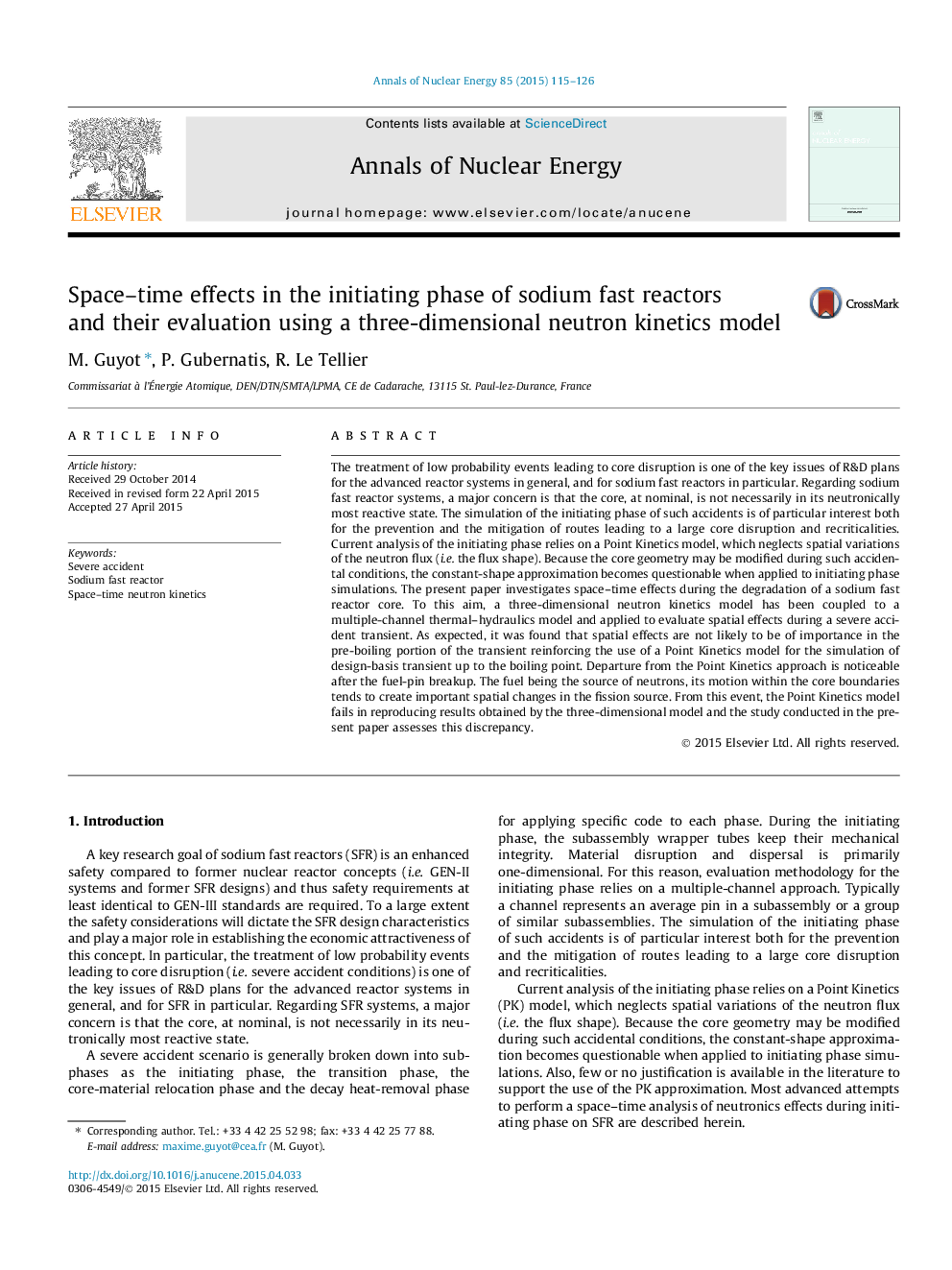| کد مقاله | کد نشریه | سال انتشار | مقاله انگلیسی | نسخه تمام متن |
|---|---|---|---|---|
| 8068162 | 1521113 | 2015 | 12 صفحه PDF | دانلود رایگان |
عنوان انگلیسی مقاله ISI
Space-time effects in the initiating phase of sodium fast reactors and their evaluation using a three-dimensional neutron kinetics model
ترجمه فارسی عنوان
اثرات فضا-زمان در فاز شروع راکتورهای سدیم سریع و ارزیابی آنها با استفاده از مدل سه بعدی سینتیک نوترون
دانلود مقاله + سفارش ترجمه
دانلود مقاله ISI انگلیسی
رایگان برای ایرانیان
کلمات کلیدی
تصادف شدید، راکتور سریع سدیم، فضا زمان سینتیک نوترون،
ترجمه چکیده
درمان وقایع کم احتمال منجر به اختلال در هسته یکی از مسائل کلیدی برنامه های تحقیق و توسعه برای سیستم های پیشرفته راکتور به طور کلی و برای راکتورهای سدیم به ویژه است. با توجه به سیستم های رآکتور سریع سدیم، نگرانی عمده این است که هسته، در اسمی، لزوما در حالت واکنشی نوترونی نیست. شبیه سازی فاز شروع چنین حوادثی، برای پیشگیری و کاهش مسیرهایی که منجر به اختلال و ناهماهنگی در هسته اصلی می شود، مورد توجه خاص است. تجزیه و تحلیل جاری از فاز شروع به تکیه مدل کینتیک نقطه، که تغییرات فضایی شار نوترون (شکل شار) را نادیده می گیرد. از آنجا که هندسه هسته ای ممکن است در چنین شرایط تصادفی اصلاح شود، تقریب شکل ثابت در هنگام استفاده از شبیه سازی فاز شروع می شود. در این مقاله اثرات فضا-زمان در هنگام تخریب هسته راکتور سدیم سریع بررسی شده است. برای این منظور، یک مدل سه بعدی سینتیک نوترونی به یک مدل حرارتی هیدرولیکی چند کاناله متصل شده و برای بررسی اثرات فضایی در طول گذر زمان ناگوار شدید استفاده شده است. همانطور که انتظار می رفت، متوجه شدیم که اثرات فضایی در بخش پیش از جوش گذار از گذر زمان، تقویت استفاده از مدل سینتیک نقطه برای شبیه سازی مبنای طراحی تا نقطه جوش، مهم نیست. خروج از رویکرد نقطه کینتیک پس از شکستن پین سوخت قابل مشاهده است. سوخت منبع نوترون است، حرکت آن در داخل مرزهای هسته تمایل به ایجاد تغییرات فضایی مهم در منبع تقسیم دارد. از این رویداد، مدل نقاط سینتیکی در بازتولید نتایج حاصل از مدل سه بعدی ناکام ماند و مطالعه انجام شده در مقاله حاضر این اختلاف را ارزیابی می کند.
موضوعات مرتبط
مهندسی و علوم پایه
مهندسی انرژی
مهندسی انرژی و فناوری های برق
چکیده انگلیسی
The treatment of low probability events leading to core disruption is one of the key issues of R&D plans for the advanced reactor systems in general, and for sodium fast reactors in particular. Regarding sodium fast reactor systems, a major concern is that the core, at nominal, is not necessarily in its neutronically most reactive state. The simulation of the initiating phase of such accidents is of particular interest both for the prevention and the mitigation of routes leading to a large core disruption and recriticalities. Current analysis of the initiating phase relies on a Point Kinetics model, which neglects spatial variations of the neutron flux (i.e. the flux shape). Because the core geometry may be modified during such accidental conditions, the constant-shape approximation becomes questionable when applied to initiating phase simulations. The present paper investigates space-time effects during the degradation of a sodium fast reactor core. To this aim, a three-dimensional neutron kinetics model has been coupled to a multiple-channel thermal-hydraulics model and applied to evaluate spatial effects during a severe accident transient. As expected, it was found that spatial effects are not likely to be of importance in the pre-boiling portion of the transient reinforcing the use of a Point Kinetics model for the simulation of design-basis transient up to the boiling point. Departure from the Point Kinetics approach is noticeable after the fuel-pin breakup. The fuel being the source of neutrons, its motion within the core boundaries tends to create important spatial changes in the fission source. From this event, the Point Kinetics model fails in reproducing results obtained by the three-dimensional model and the study conducted in the present paper assesses this discrepancy.
ناشر
Database: Elsevier - ScienceDirect (ساینس دایرکت)
Journal: Annals of Nuclear Energy - Volume 85, November 2015, Pages 115-126
Journal: Annals of Nuclear Energy - Volume 85, November 2015, Pages 115-126
نویسندگان
M. Guyot, P. Gubernatis, R. Le Tellier,
